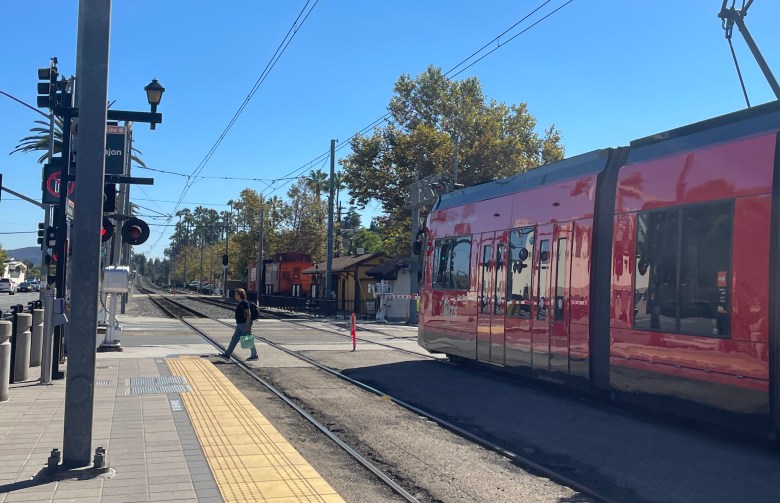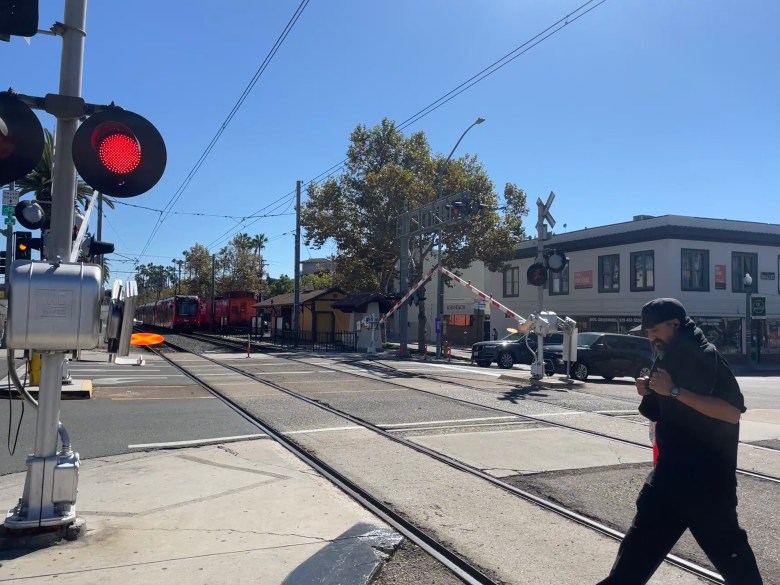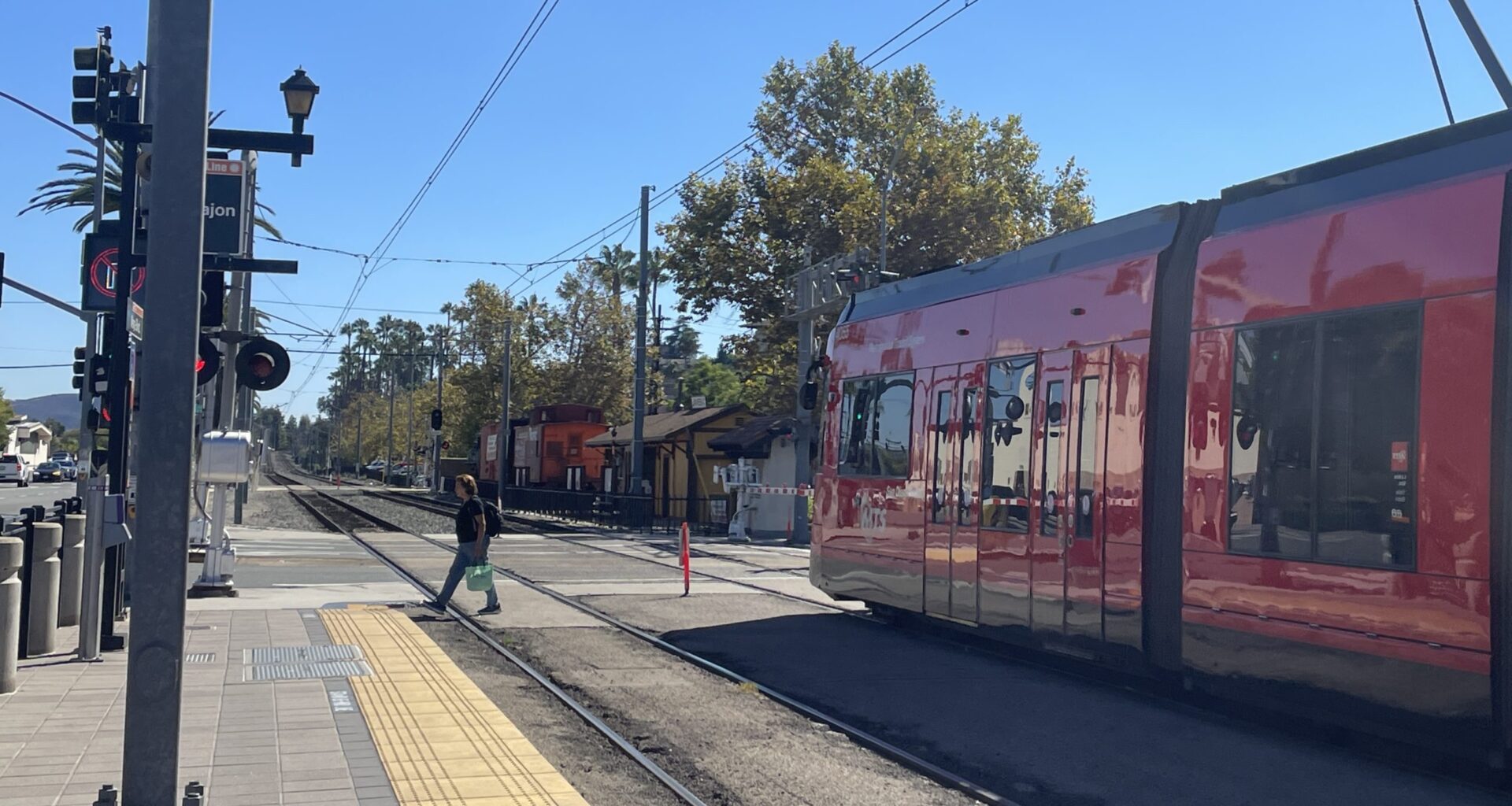Overview: Trolley project
At Friday’s La Mesa Village Farmers Market, SANDAG and city officials will hold a pop-up to collect feedback. The proposed project aims to make the trolley stop intersection at La Mesa Boulevard and Spring Street safer.
 Trolley arrives at the La Mesa Boulevard stop. (Photo by Calista Stocker/Times of San Diego)
Trolley arrives at the La Mesa Boulevard stop. (Photo by Calista Stocker/Times of San Diego)
The city of La Mesa, in partnership with SANDAG, recently announced a major upgrade project for the San Diego Trolley and residents will have a chance to weigh in on Friday.
The Downtown La Mesa Trolley Prioritization Project aims to make the trolley stop at La Mesa Boulevard and Spring Street safer through one of three track relocation concepts.
At Friday’s La Mesa Village Farmers Market, from 3 to 7 p.m., SANDAG and city officials will hold a pop-up to collect feedback. There is also an ongoing SANDAG survey on the proposed project.
One option is to raise the trolley tracks above street level, another is to trench the tracks underground and the third is to lower the street. All three options would be a massive undertaking, both in time and money.
However, with the San Diego Association of Governments, commonly known as SANDAG, expecting trolley service to double by 2035, keeping the intersection as it is could cause major traffic delays and safety issues for motorists, trolley users and pedestrians.
The project is in its infancy and officials have not completed studies on the proposed concepts, meaning construction is likely a decade away.
According to Colin Parent, a former La Mesa councilmember and CEO/general counsel of Circulate San Diego, the La Mesa Boulevard and Spring Street intersection reports the highest number of serious crashes. Circulate San Diego data from 2018 reflects similar results.
Additionally, Parent said La Mesa has the most trolley stops per capita compared to all other cities in the county.
 Crossing gates open for cars at the La Mesa Boulevard trolley stop. (Photo by Calista Stocker/Times of San Diego)
Crossing gates open for cars at the La Mesa Boulevard trolley stop. (Photo by Calista Stocker/Times of San Diego)
“We have an abundance of trolley access,” Parent said. “Even people who don’t use it very often like that it’s there because they use it sometimes to go to a Padres game or to go to a concert, something like that. But it’s also true that most people in La Mesa are motorists and don’t ride the trolley as a commuter and find and feel that they are being, more often than not, inconvenienced by the trolley, as opposed to finding it useful.”
While Parent does not believe SANDAG currently has the financial resources to reach its goal of doubling trolley service, he argued that raising the trolley tracks is generally a good idea.
“Having an elevated line is probably more feasible and also almost certainly less expensive,” Parent said. “But you know, some people won’t like how that looks and it will sort of change the look and feel of parts of the city. But [it’s] something folks ought to consider and be open to, both to improve safety and also to make sure that everyone’s able to move relatively quickly and safely through that intersection and corridor.”
For Parent, the Trolley Prioritization Project would help motorists, but not other transit concerns such as safety and cleanliness.
However, La Mesa Vice Mayor Lauren Cazares is open to the possibility of the project making way for trolley improvements.
“While I don’t think this will necessarily do anything directly for the cleanliness of the trolley, it really is giving us the opportunity to have more control over the lighting and other safety features that may make people feel safer to ride the trolley,” Cazares said.
Like the rest of the county, La Mesa has experienced steady population growth.
However, Cazares says downtown events, such as Oktoberfest and Holiday in the Village, attract more and more visitors every year.
“Not only are we having more people move into La Mesa, but downtown La Mesa has really become a regional destination, and so we want to make sure that we are as accessible as possible, while also keeping with the character of our community,” she said.
Collecting feedback is key
Due to the potential impact of all three proposed options on visitors, residents and businesses, Cazares emphasized the importance of collecting feedback from local organizations and community members.
“Obviously, construction — when this does go to construction — is going to have an impact, but that is why it’s so important that it’s not just the city council or SANDAG Board of Directors who’s choosing the design that we like best, but it needs to be the design that works best for our community, for our small businesses and for our trolley riders,” Cazares said.
Cazares encouraged the community to attend Friday’s pop-up, but also to email their thoughts to eng@cityoflamesa.us, pio@sandag.org or lcazares@cityoflamesa.gov.
READ NEXT
